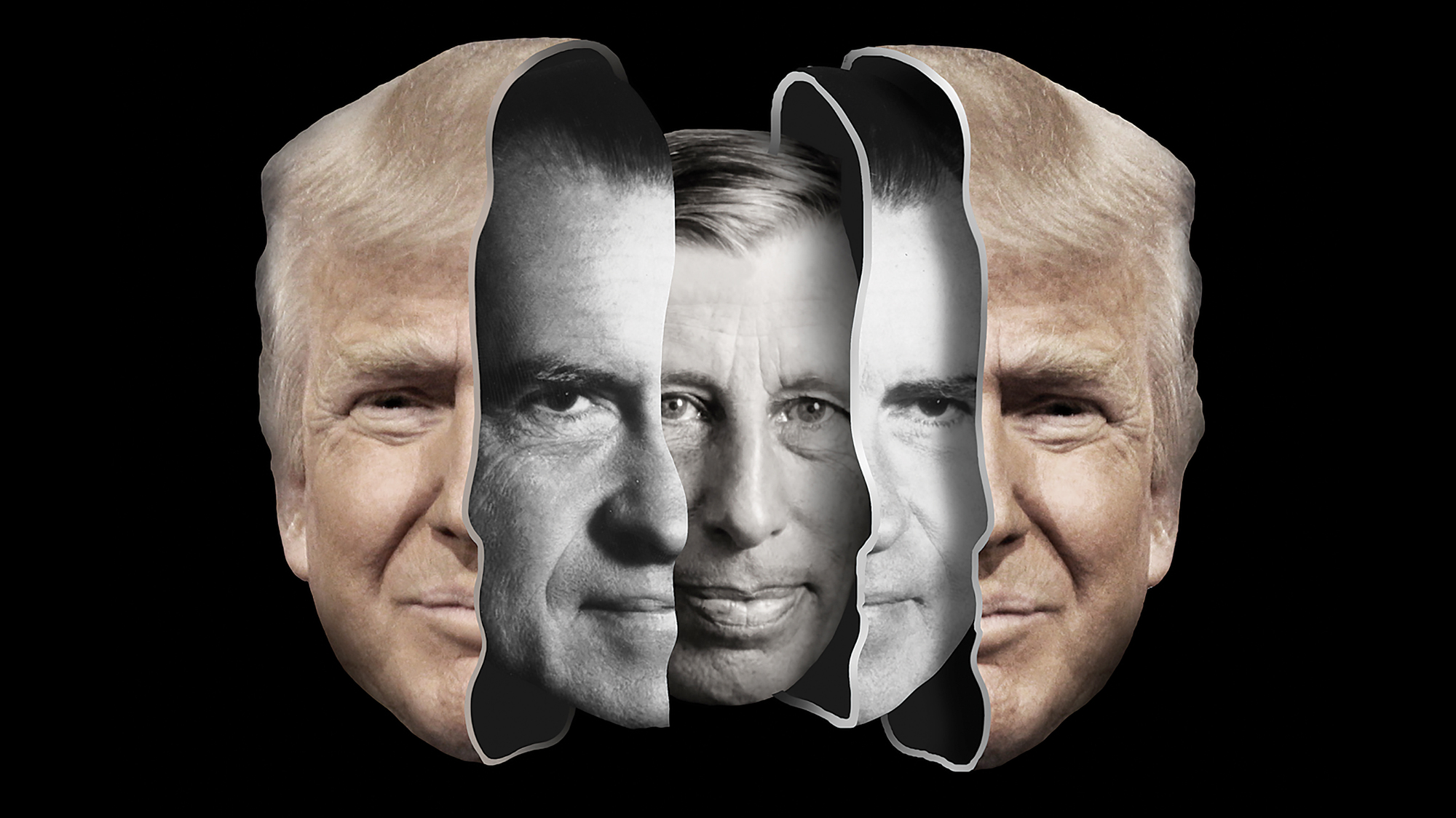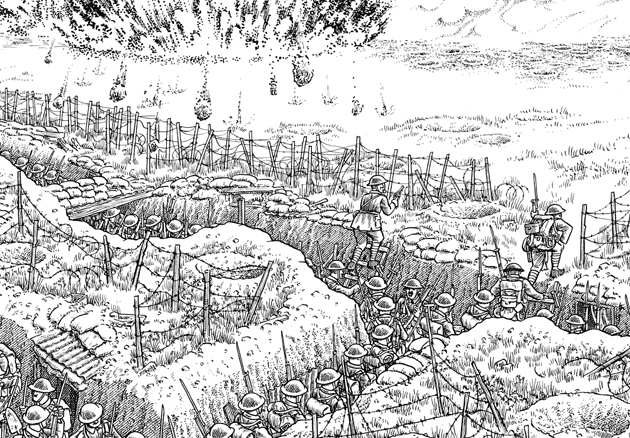Manila, 1901. The city is a steamy mix of grand Spanish colonial buildings mildewed from tropical humidity, the ramshackle dwellings of hundreds of thousands of Filipinos, and horse-drawn wagons rumbling through squares and gates with names like Plaza de Cervantes and Puerta de Isabel II. Hastily erected hotels, houses of prostitution, and gambling dens cater to a flood of newly arrived Americans: bureaucrats, missionaries, merchants, speculators—and soldiers. Despite its swift victory in the Spanish-American War three years earlier, the United States is now in the middle of its first protracted war in Asia. Filipino nationalists, delighted to be free at last from several centuries of Spanish rule, have discovered that the US troops with leggings tucked into their high boots whom they first hoped were liberators are in fact here to establish an American colony. The brutal conflict now underway will eventually leave more than 200,000 Filipinos dead.
Although he may have watched the Army vs. Marines baseball games while off duty, Captain Ralph H. Van Deman was almost certainly too abstemious to loiter in the city’s bars and brothels or place bets at the Manila Jockey Club, but for an ambitious US Army officer, wartime Manila was nevertheless the place to be. Van Deman was far from the usual picture of a dashing young warrior: tall, gray-eyed, and almost cadaverously thin, he had a long, hawklike face and ears that seemed to jut out from his head at right angles. His route to the military had been an unusual one, because after attending college first in Ohio and then at Harvard, he had studied law for a year, then completed medical school. An early experience that may have influenced him more than these many classrooms, however, was his service, during his student years, in the Ohio National Guard when it suppressed a violent coal miners’ strike. By 1901, Van Deman had been on active duty for 10 years.
When he took up a new post in Manila in February that year, the lanky 35-year-old polymath at last discovered his métier, an endeavor that would remain an obsession for the rest of his life. The conflict in the Philippines, now largely forgotten, was a counterguerrilla war, and for that, the US military needed not battleships and fortresses, but intelligence information. In an old Spanish military building in a walled quarter of the city, Van Deman was placed in charge of the Bureau of Insurgent Records—a post that would turn him into the founding father of American surveillance. His assiduous spying in war and peace would span half a century and three continents, and presage a vengeful nastiness eerily familiar to us today: racial stereotyping, the smearing of political enemies with fact-free rumor, and charges that those who opposed US government policy were unpatriotic or treasonous. Van Deman’s career would culminate in helping a particularly unscrupulous future president on his path toward the White House.
In Manila, the American occupation authorities were deeply alarmed that so many Filipinos wanted independence. Van Deman put the Army’s intelligence operation into high gear, ordering 450 officers throughout the archipelago to provide data “from every possible source” on all mayors, priests, and “active civilian sympathizers.” As a sign of his operation’s growing importance, it was moved to US Army headquarters on the bank of the Pasig River, one floor down from the commanding general. To compile his storehouse of data on suspect Filipinos, Van Deman used the most sophisticated information management system of his day: file cards. Each was printed at the top, “Descriptive Card of Inhabitants,” and had spaces for an American officer to fill in such details as a person’s appearance, age, occupation, “blood connections,” and “relative importance in the community.”
The prisoner Santiago Nepomuceno, for example, suspected of killing an American, was “very ignorant and depraved.” Escolastico Salandanan was “very thick with former leading insurgent officers.” Under the “Attitude toward U.S.” section of the cards, comments range from “doubtful” and “presumably treacherous” to “ostensibly very friendly, but in his heart I believe him strongly antagonistic to Americanism.”
For the data on his cards, Van Deman drew not only on US Army officers but on the territorial and Manila police, both under American control. In the capital alone, his office had 200 undercover agents on the payroll. Tips also flowed in from the tax and customs authorities. Combined, writes University of Wisconsin history professor Alfred W. McCoy, who has closely studied Van Deman’s career, these forces contributed to “a modern surveillance state.” Surveillance, of course, is always about control—in this case suppressing the independence movement. It soon withered, not only because of American military might but because nationalists suspected, correctly, that their organizations were infiltrated.
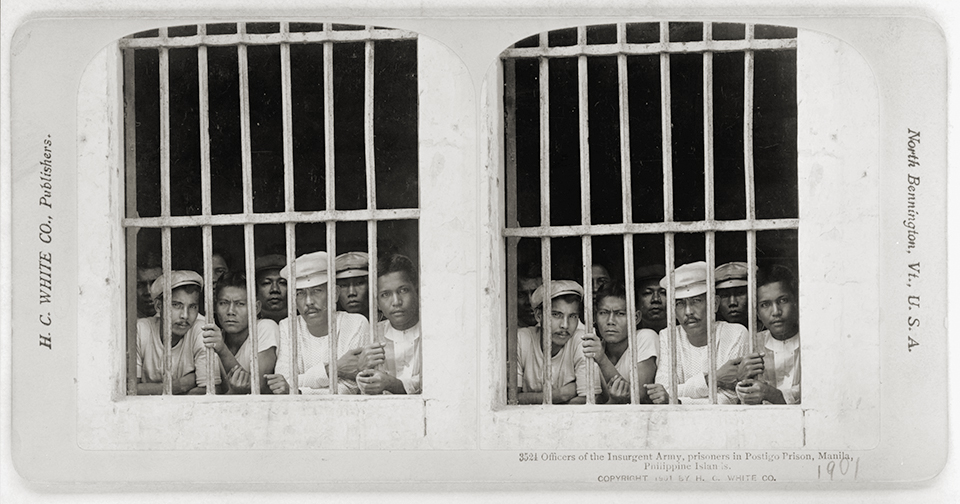
A stereograph of nationalist officers imprisoned in Manila, 1901
Library of Congress
On the thousands of Van Deman’s dusty file cards that survive today, one fact goes eerily unmentioned: Much of the information about these Filipino patriots was obtained by torture. The US Army’s routine method of interrogation on the islands was a precursor to modern-day waterboarding. “Now, this is the way we give them the water cure,” an infantryman named A. F. Miller wrote to his family in Nebraska in 1900. “Lay them on their backs, a man standing on each hand and each foot, then put a round stick in the mouth and pour a pail of water in the mouth and nose, and if they don’t give up pour in another pail. They swell up like toads.” Photographs show Filipinos enduring this.
Why, according to Van Deman, did these “insurgents” want independence? “This was owing principally, I am sorry to say, to advice from anti-imperialist and anti-administration citizens in the United States,” he told his Harvard classmates in a volume of autobiographical reports. “God only knows how many Filipino and American lives these people are responsible for.” Like so many white men of his era, he felt anyone who resisted colonialism must be a dupe of outside agitators.
The security apparatus Van Deman helped build would last through several decades of American colonial rule. By the 1920s, Manila’s police force would have some 200,000 alphabetized file cards covering fully 70 percent of the population, a surveillance lover’s dream. As in so many countries since then, ruthless police and military forces built or heavily aided by the United States have continued to burden the Philippines ever since the country finally became independent in 1946.
Van Deman was not the only white man of his era who saw colonialism as natural. It was Rudyard Kipling, after all, who had urged America to “take up the white man’s burden” by annexing the islands. Caucasians, millions believed, had a God-given right to rule everywhere over their black and brown inferiors. Among those who disagreed, however, were some of the 6,000 black US Army soldiers who took part in the Philippine War. Horrified generals withdrew some “colored regiments” ahead of schedule after at least 20 black soldiers deserted, most joining the other side. Van Deman would have heard much talk of such doings over the Australian beef and French wines at Manila’s Army and Navy Club. His belief that black Americans were not to be trusted would become a cornerstone of the next stage of his work.
After returning home, in 1903 Van Deman married a woman 15 years younger. Like so many women of her time, Sadie Van Deman left little trace in the written record, with one startling exception: She was the first woman in the Americas to fly. A friend of Katharine Wright, the sister of Wilbur and Orville, she asked if she could join Wilbur on a four-minute flight in 1909. On several later trips, he allowed her to take the controls. After some years, however, the couple divorced. Van Deman continued to rise up the military promotion ladder and was selected for the first class to attend the new Army War College. In early 1917, he married again, and that union would last.
At this time, the United States was bitterly torn over whether to enter the vast, bloody war raging in Europe. Many Americans resisted the push to war, particularly radicals who believed that workers should be fighting the ruling class, not each other. But public outrage was rapidly growing over the sinking of American ships by German submarines and the notorious “Zimmerman Telegram” from the German foreign minister urging Mexico to ally itself with Germany and regain its “lost territory in Texas, New Mexico, and Arizona.” The day that President Woodrow Wilson went to Congress to call for war, an angry mob broke into the headquarters of the Emergency Peace Federation across the street from the White House, smashing chairs and desks and spattering the office with yellow paint. When the New York Yankees played their season opener the following week, they marched onto the diamond in military formation, resting bats on their shoulders like rifles.
America’s declaration of war on April 6, 1917, found the gaunt figure of Van Deman stuck in a staff position at the War Department, frustrated that the Army did not have an intelligence agency. He put this proposal to the Army’s chief of staff, General Hugh Scott, who turned him down. Then he made an adroit but risky leap over Scott’s head and used two go-betweens to place the idea before Secretary of War Newton Baker. His lobbying was successful, and Baker ordered him to set up a new Army intelligence branch. Soon promoted to colonel, Van Deman pursued the task with zeal, his staff swelling to 282 officers, 29 sergeants, and more than 1,000 civilians, most of them volunteers.
The war Van Deman was intent on waging was not in the trenches of France, but at home. In his mind, Germany and its allies were far from the only enemy. The year 1917 also saw the Russian Revolution, and the triumph of the Bolsheviks greatly inflamed American political tensions: between powerful captains of industry and a militant labor movement; between the long-dominant Protestants of northern European descent and waves of later immigrants, mostly Catholic and Jewish, who were often sympathetic to socialism and anarchism; and between the propertied classes of small towns—like Van Deman’s native Delaware, Ohio—and the rapidly growing big cities that seemed filled with threatening foreigners and radicals.
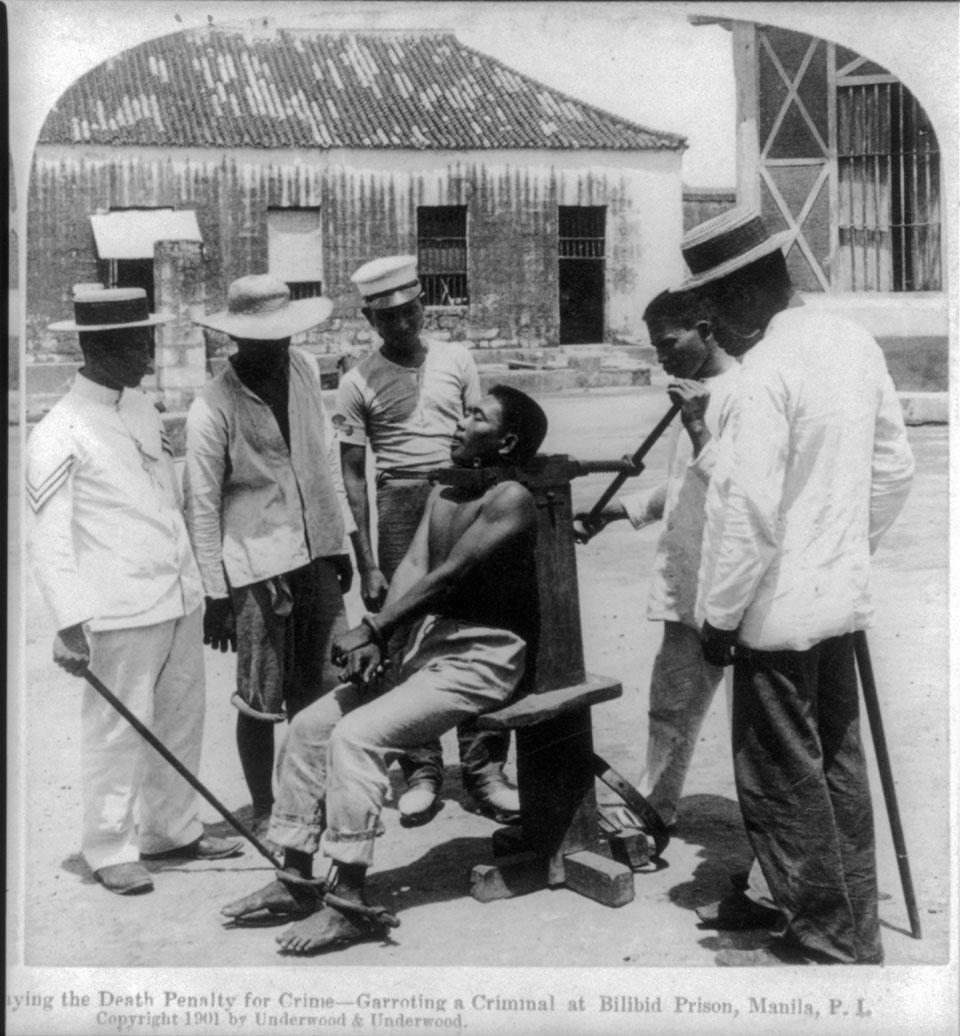
Paying the death penalty for crime—garroting a criminal at Bilibid Prison, Manila, P.I.
Library of Congress
Van Deman could amass his huge staff because his worldview so embodied that of the American establishment of his time. He saw himself as defending the traditional social order against rebels at home and revolutionary ideologies from abroad. He deeply distrusted immigrants, people of color, and any political activism they engaged in. He warned the Justice Department, for instance, of weekly meetings at the home of the principal of the Colored High School in Baltimore, “presided over by a white man” of “loose habits” who had allowed talk that “the atrocities committed by Germany are no worse than the lynchings and burnings which have taken place in the South.”
“In the fall of 1917,” he later wrote, “it became evident that agents of the Central Powers were circulating among the Negro people of the United States.” This was nonsense, for it did not take any German or Austro-Hungarian spies to make black Americans angry that they were forced into underfunded schools and low-paid jobs, and that in the first two decades of the 20th century alone more than 1,400 black men were lynched.
Nothing was beyond suspicion. One report to his office related “several incidents of where [sic] colored men had attempted to make appointments with white women.” Van Deman was ready to believe the wildest of rumors, asking one agent to investigate word that “fortune tellers, supposed to be gypsies…[are] entering the kitchens of well-to-do residents and telling the fortunes of the servants. These fortunes…all point out that unless Germany wins the war the colored race will be made slaves again.” He gave credence to another claim that Germans stirring up blacks were going door to door posing as sewing-machine salesmen. From an agent in New York came a report that “German money in large sums is being used in the Harlem district among the negro population” to purchase $600,000 worth of property.
Just as in the Philippines, surveillance was about control. When a Howard University dean wrote a pamphlet against lynching, Van Deman sent an agent to have a stern talk with him. Black newspapers were monitored closely—and threatened. The most influential, the Chicago Defender, was visited by one of his agents, who reported that the editor had “been told that he would be held strictly responsible and accountable for any article appearing in his paper in the future that would give rise to any apprehension…I have…informed him that the eye of the government is centered upon his paper.” Van Deman urged the YMCA to keep the NAACP’s The Crisis out of its reading rooms, where it might be seen by black soldiers.
One object of his intelligence unit’s suspicions in 1917 was the Reverend A. D. Williams, the pastor of Ebenezer Baptist Church in Atlanta. A forceful organizer, Williams helped put together an Equal Rights League to protest discrimination in voting, and he helped set up a branch of the NAACP that would register black voters. “It behooves us,” said one telegram, “to find out all we possibly can about this colored preacher.” A report in Williams’ file termed him a “radical Negro agitator” because of his campaign to create a black high school. The grandson of “this colored preacher” would eventually become a pastor of the same church and in turn the subject of a later generation of government surveillance: Dr. Martin Luther King Jr.
Another group Van Deman went after was labor organizers. As with anti-lynching campaigners, he was convinced that such homegrown organizations as the Industrial Workers of the World, the “Wobblies”—founded in Chicago well before the war—must be connected to the enemy. He asked for a federal investigation of deposits made in Wobbly bank accounts in Arizona and referred to “the many rumors that the recent I.W.W. activities are supported by funds from German sources.”
Also under suspicion was the Conference of Christian Pacifists in California, a group he judged “watery and neutral as far as its war loyalty is concerned.” In a letter to the secretary of war’s office, he boasted of his threats against the organization: “Ample warning…has been given to all concerned in these activities. Public opinion finally was aroused at various points on the Pacific Coast regarding their pernicious public gatherings.” To the warden of the federal penitentiary in Atlanta, where the anarchist Emma Goldman was locked up, Van Deman sent word that Goldman was still wielding influence from behind bars and suggested “that it might be well to place greater restrictions upon her.”
Always alert to possible rivals, Van Deman artfully blocked an attempt by the Army’s Signal Corps to start its own domestic counterespionage operation. And, however unreliable it was, the stock of intelligence gathered by his huge staff allowed him to deal with officials who far outranked a mere colonel. He corresponded, for example, with former President Theodore Roosevelt, and with the governor of Montana, whom he warned about a possible mining strike. Cabinet members and newspaper correspondents were regular guests at a weekly luncheon he hosted at military intelligence headquarters, known as the General Hindquarters.
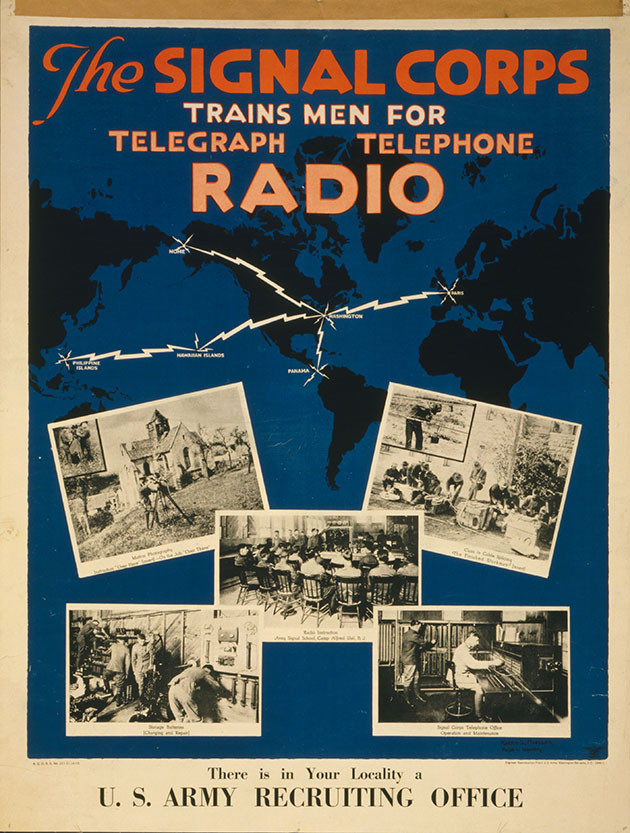
But then he fatally overreached, in testifying before the Senate Military Affairs Committee in April 1918. The country needed military tribunals to take “quick and summary action” against Americans who opposed the war, he told the senators, because the existing courts were “tied up with forms and red tape and law.” Note the last word.
Despite the administration’s draconian crackdown on anti-war dissent, President Wilson immediately declared himself “wholly and unalterably opposed” to such tribunals. By this point, senior military and Justice Department officials were feeling their power threatened by Van Deman’s burgeoning surveillance empire and saw to it that he was dispatched, with only the vaguest of assignments, to Europe.
For a skilled navigator of the military hierarchy, however, this merely offered new opportunities, particularly since the American commander at the front, General John J. Pershing, was an Army War College classmate. When the fighting ended, Van Deman managed to get himself placed in charge of all security arrangements for the monthslong peace conference at Versailles, with a staff of 56.
Paris in the spring of 1919 was a social climber’s dream: There was a whirl of military band concerts and embassy dinners and balls, as Allied diplomats and generals exultantly redrew the maps of Europe, Africa, and the Middle East with little thought of where the smoldering resentment of defeated Germany might lead. Van Deman’s letters home to his wife, Irene, known as Cherry, are a curious mixture of passion (“Cherry dearest…to think of holding you tight in my arms again!”), dire political warnings (“There is a widespread attempt to start a world revolution along Bolshevic [sic] lines”), and bureaucratic triumphs (“Gen. Pershing had personally told the Adjutant General… to issue an order saying definitely that I was to perform my duties in connection with the Peace Commission in addition to my other duties and that I was not to be detached from G-2, G.H.Q.A.E.F.”).
After Versailles, Van Deman resumed his rise in the Army, although jealous rivals kept him away from anything to do with intelligence. When he retired in 1929, it was as a major general.
With its balmy climate and dense array of Army, Navy, and Marine bases, San Diego had long been a favorite spot for those leaving the armed forces, and that was where the Van Demans settled. His friends included many other retired military men, and he found this conservative part of the country congenial. Even local labor leaders had a right-wing bent, and San Diego—with only a small Latino population at that point—was dominated by a Protestant, Anglo oligarchy, a far cry from the East Coast cities filled with recent immigrants and subversive ideas.
Within a few years of moving to San Diego, Van Deman embarked on yet a new phase of his passion for surveillance. The operation to which he would devote the remaining two decades of his life did not even have a name. With volunteer help from his wife and a retired officer friend, plus two clerks paid for by the Army, he quietly created a private intelligence bureau. Its records came to almost fill an apartment adjoining his own. “I’m sure I am not exaggerating,” he wrote in a Harvard class report, “when I say that since 1932 I have devoted at least twelve hours a day to this work.” His efforts were aided by funds, he hinted, contributed by wealthy sympathizers. As in the Philippines 30 years earlier, to record details about people he was watching, Van Deman used file cards. Eventually, 85,000 of them would index and summarize the contents of a dozen filing cabinets containing more than 90 linear feet of agents’ reports, photographs, letters, and other documents. “It was a rare Red,” the San Diego Union would write years later, “whose appearance in this area was not noticed.”
“Essentially Van Deman was a vigilante,” says Athan Theoharis, a professor emeritus of history at Marquette University and the author of a number of books about the FBI and surveillance. “A self-appointed one. Talk about a true believer! This was his life’s work. He saw himself as a savior of the nation. He had this mission, which was amazing in terms of the amount of information he collected and turned over to people who could act on it.”
Among those who did were district attorneys eager to prosecute subversives and employers’ groups who wanted to know who was trying to organize their workers. Always an adroit networker, Van Deman traded information with them as well as with police and sheriffs’ departments and old friends in military intelligence who were spying on civilians. One Army unit in San Francisco made copies of so much material for him that it made a rubber stamp, “VanD.” An official in the San Diego post office, writing to “My dear General,” happily supplied the return addresses of packages and letters sent to an unnamed “person in regard to whom we have had recent conversation.”
For hunters of subversives, the 1930s were busy years. The devastating toll of the Great Depression spurred the growth of radical and socialist groups. Police red squads cracked heads at picket lines while organizations from the American Legion to the US Chamber of Commerce set up departments to hunt Communists. Nowhere were tensions higher than in California, where existing hunger and joblessness were exacerbated by desperate migrants fleeing into the state from the Dust Bowl.
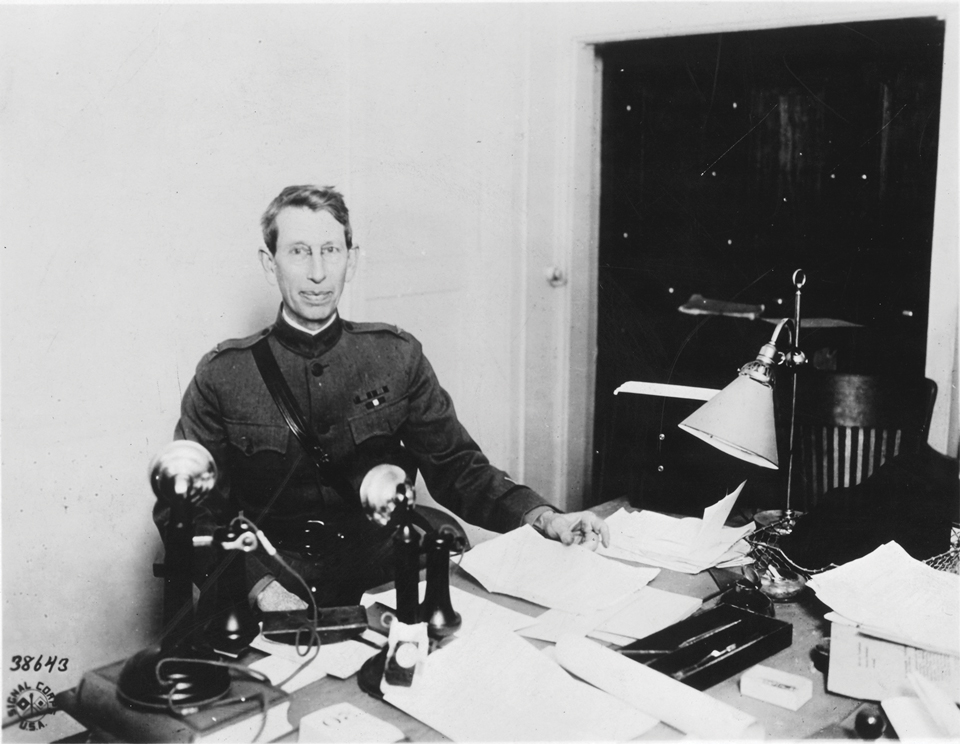
Van Deman during his posting as “director of negative intelligence” (i.e., security chief) at the Paris Peace Conference in 1919
Ralph H. Deman papers / Hoover Institution Archives
Van Deman’s undercover agents monitored the Communist Party so thoroughly that one account reports on a party meeting that drew only four people. Nonetheless, the general accumulated reports on everything from a Young Marxian Pioneer Troop to “Airplane Pilots with Red Tendencies.” For him, surveillance was a matter of love—or, as he would say, patriotism—not money. He apparently charged no one for the information he shared, even though detective agencies were making the same kind of espionage a multimillion-dollar business; in the mid-1930s, Pinkerton alone employed 1,200 spies in various industries.
Communists were indeed working with, among others, the state’s miserably paid farmworkers, many of them Mexican or Mexican American. Grower organizations like the Associated Farmers of California became grateful consumers of Van Deman’s information. From friends in Navy intelligence in 1933, the general heard that a Communist named James Dixon would be organizing a strike of celery pickers near San Diego, word he relayed to others in his network. He exchanged information about a lettuce harvesters’ strike with the district attorney of Imperial County, a place where labor protesters were repeatedly beaten up by vigilantes deputized by local sheriffs and police. When San Francisco saw a massive waterfront strike in 1934, Van Deman obtained a list of suspected agitators and was soon discussing the situation with the city’s Industrial Association.
Although much data in his files came from police departments or other agencies, thousands of pages are from his own undercover operatives. Some of the correspondence is written in invisible ink, with agents identified only by letters and numbers. B-11, for example, was a particularly active fellow who posed as a Communist recruiting seamen and then farmworkers, and who reported on a meeting of the American Civil Liberties Union—a frequent target of the general’s scrutiny. Another agent posed as a delegate to a convention of the Cannery and Agricultural Workers Industrial Union. The general’s crew was not above the occasional burglary: Agent C-14 provided a list of distributors and subscribers of the Communist newspaper People’s World—“found in trunk of Celia Shermis’ car.”
By now, Van Deman had also grown obsessed with the film industry. A report on the movie star James Cagney notes darkly that “he wrote a piece for the Screen Actors Guild, which…is the employes [sic] rebellion against the producers.” In Here Comes the Navy, Cagney’s character “is antagonistic to and creates hatred for his superior officers.” Even more sinister, Cagney had reportedly contributed to a relief fund for striking cotton pickers.
Schools and colleges were another arena for vigilance. An ally on the San Diego Board of Education used the Van Deman files to vet anyone who applied to host an event on school property. A long list of “Radical Professors and Teachers” ranged from Columbia University to Milwaukee State Teachers College. A list of suspicious professors at UCLA and the University of Southern California noted that one was “an admirer of Upton Sinclair” and another was “questionable…is married to a Polish Jewess.”
Jews, indeed, were often among Van Deman’s targets. In a letter to an Army colleague, he declared himself “convinced that there may be more than a modicum of truth” in the connection between “Bolshevism and Semitism.” The general trafficked in conspiracies, and one document in his files reports on a veritable trifecta of villains by citing a “Yiddist [sic] pamphlet” that “urges the Masonic Fraternity to come to the support of the Soviet Union.” Duly filed as well is a chart someone sent in claiming that both Franklin and Eleanor Roosevelt had Jewish ancestry.
Among other sources feeding Van Deman’s anti-Semitism was agent B-31, one of the few operatives whose name we know; historian McCoy has identified her as a California advice and gossip columnist, Mary Oyama Mittwer. During a 1946 trip to the East Coast, she reported that “organized Jewry is out to control organized labor.” Furthermore, “the Jewish people are slowly but surely securing a stranglehold on the poultry and egg business.” And worse lay ahead: Jewish refugees “are coming in here by the shiploads, they have Hotels in NY City where they are re-outfitted, their jewelry is turned into cash; and then…homes are purchased for them.” A shadowy plot was behind it all: “Felix Frankfurter and possibly Henry Morgenthau manage to pull a lot of strings in the background…The motion picture and stage industry…is practically controlled by the Jewish race.”
The general was deeply suspicious of President Roosevelt and the people around him. One report notes that Frances Perkins—longtime secretary of labor and the first woman in an American Cabinet—“admitted her married name is Mrs. Paul Wilson.” A follow-up investigation Van Deman ordered to this apparently incriminating piece of information produced a copy of a 1910 Massachusetts marriage certificate showing a Paul Wilson marrying someone else—possible evidence of further skullduggery. (The general had both the date and place wrong: Perkins had quite publicly married another Paul Wilson in New York in 1913.)
During these California years, Van Deman found what every zealot yearns for: a disciple. This was a younger man named Richard Ellis Combs. For the nearly two decades that their professional lives overlapped, Combs considered the general his mentor, living for a time with him and his wife in San Diego. “Van Deman taught me that to master the field of subversion,” he said years later in a rare interview, “you must read with notebook in hand, summarize everything, then type your own file card…You must do this yourself. You can’t divide the job and let a secretary help. You do it and it becomes your knowledge, your resource. After a while, you will command everything in the field.”
In 1941, the tall, red-haired Combs began an influential 30-year tenure as chief counsel and lead investigator for the California Un-American Activities Committee, or CUAC. This was the most powerful and choleric of the state legislative groups that echoed witch-hunters at the national level, like the House Un-American Activities Committee (HUAC) and later Sen. Joseph McCarthy.
Over the years, bolstered by intelligence passed on by Van Deman, CUAC held hearings, fiercely grilled witnesses, and built up its own gargantuan files, which eventually came to cover 125,000 individuals and organizations. Even public school sex education programs in the town of Chico came under the committee’s scrutiny as possibly Communist-inspired.
We don’t know everything Van Deman and Combs did together because the general was always discreet. “There are a lot of things that I want to talk over with you when you come down,” he once wrote to Combs, “which are just as well not put on paper.” But we do know that the two strategized how to use the mysterious death of a UCLA student after attending a political meeting in 1948 to fan the flames of anti-communism. Their efforts helped feed a frenzy that soon resulted, among other things, in the University of California requiring all employees to sign a loyalty oath. The subsequent firings of those who refused to sign sent a chill through the state’s entire educational system.
In his zeal for surveillance, his sweeping hostility to African American activism, and his approval of black-bag jobs by his agents, Van Deman foreshadowed no one so much as a figure 30 years his junior, J. Edgar Hoover. Indeed, the two men knew each other. Van Deman always had an eye for those on the rise, and in 1922 he had pulled strings to get an Army Reserve commission for Hoover, then a 27-year-old Justice Department official. In the next decade, the general resumed contact with Hoover. His letters to the FBI chief were almost fawning; in 1938, he apologized for having made “an attempt to break in on the privacy of a very busy man trying to get a little well-earned rest.” Van Deman’s courting of Hoover was successful, however, because he was included in a crucial meeting Hoover hosted in the run-up to American participation in the Second World War. On May 31, 1940, Hoover gathered in his office high officials from the Army, Navy, and State Department to divide up intelligence-gathering territory. “This was like the pope dividing the unexplored world [between Spain and Portugal] in 1493,” says McCoy. “The FBI got counterintelligence at home—and operations in Latin America. Military intelligence, out of which the OSS and then the CIA evolved, got the rest of the world.”
Van Deman’s presence at the meeting is testimony to his ability to ingratiate himself with the powerful, because at this point he had been retired from the military for 11 years and had no government job. Hoover soon asked a San Diego FBI agent to “devote himself exclusively to the task of reviewing General Van Deman’s files and extracting all information of value to the Bureau.”
The FBI came to rely on Van Deman’s archive so much that the general developed a library card system showing when the bureau had borrowed and returned a file. The FBI’s San Diego office informed Hoover that agents were in touch with the general “almost daily.” After he turned 80 in 1945, Van Deman began suffering various illnesses and an FBI man in San Diego kept Hoover apprised, sometimes giving the address of a hospital so that “the Director” could send a get-well-soon letter or telegram.
As Van Deman aged, he fretted about the fate of his treasured files. The FBI, however, began to develop a few doubts about the reliability of his data, and it also discovered a major bureaucratic obstacle to merging his files with its own: The general’s 85,000 file cards were on four-by-six-inch cards, while the FBI used three-by-five cards. Nonetheless, a few months before Van Deman died at the age of 86 in 1952, the FBI chief in San Diego recommended to Hoover that the bureau take custody of the files when the time came, because “if the General were to become aware of the fact that neither the Army nor the Bureau had any interest…this thought would most certainly leave him heart-broken, disillusioned and possibly hasten his death.”
In the end, the files continued to be used by various government agencies for well over a decade and were largely divided between the Army and a secret library maintained by friends of Van Deman in a California National Guard armory. About half the general’s documents have disappeared; the remainder eventually came to rest in the National Archives, where you can examine 97 boxes of them containing more than 42 linear feet of paper. But before the files landed there, the general’s allies stripped out a great deal of material, including the identities of the various undercover agents and of the donors who financed the vast private intelligence network. Nonetheless, the files contain much of interest, including a few hints of the support Van Deman provided to a cunning and unscrupulous politician who would reach the most powerful position in the land.
In 1946, a popular, liberal, five-term congressman from Southern California, Jerry Voorhis, was running for reelection against a political unknown—a 33-year-old former Navy logistics officer named Richard Milhous Nixon. Voorhis had explicitly rejected the endorsement of any group that didn’t disavow communism. But Nixon, onstage in a debate in South Pasadena, thunderously brandished at him a piece of paper that supposedly contained an endorsement by a Communist-infiltrated group. Nixon followed this up with a well-financed advertising campaign darkly hinting at more of the same. He pulled off a stunning upset on Election Day and quickly gained a seat on the House Un-American Activities Committee.
When Nixon went on to run for the US Senate in California in 1950, against Rep. Helen Gahagan Douglas, it was on a wave of flamboyant Red-baiting. Workers from Nixon’s phone banks called hundreds of thousands of registered voters, asked if they knew that Douglas was a Communist, and then hung up. White voters received postcards from a nonexistent Communist League of Negro Women, saying, “Vote for Helen for Senator.”
Under sunny skies at a Douglas campaign rally of 5,000 people in Long Beach’s Bixby Park, with Eleanor Roosevelt speaking, Douglas supporters noticed people passing out leaflets on pink paper that accused their candidate of sinister Communist ties. Nixon claimed that his opponent—who, he noted, was married to Jewish actor Melvyn Douglas—was “pink right down to her underwear.” The “pink sheets” helped defeat Douglas, and two years later Sen. Nixon was elected vice president.
What remains in Van Deman’s well-expurgated files shows few traces of his aiding candidates for elective office—something that would have been illegal for a man whose clerical help was provided by the US Army. Nonetheless, several clues in the 97 boxes suggest that the general played a role in Nixon’s rise to power. The ambitious young politician had been no stranger to Van Deman. He had ties to the general’s protégé, Combs, and had been a featured speaker at a conference that Combs and Van Deman had helped organize in 1948 of state Legislature Red-hunters from around the country. Van Deman’s files hold hints of the help he provided Nixon. One is a photograph of a Nixon campaign event where a demonstrator opposing the candidate is identified by one of Van Deman’s trademark code numbers. Another is an agent’s report with a revealingly hostile reference to Nixon’s adversary: “A few more Helen Gahagan Douglas’s and the left-wing congressmen will be prying open the most secret records of the federal security agencies.” Finally, Van Deman’s spies had long been collecting damaging information on Douglas’s actor husband: Agent B-11 listed him, for example, as a supporter of efforts to send bandages and clothing to victims of the Spanish Civil War, and another report identified him as part of a group of Hollywood luminaries supporting striking lettuce pickers.
California Democrats later charged that some of the scurrilous material in the Nixon campaign’s “pink sheets” against Douglas had come from Van Deman. When these accusations were renewed after Nixon became president, unnamed White House officials queried by the New York Times did not deny the charge. They said only that it was no longer “pertinent.” But for Van Deman to help Nixon at this ruthless stage of his ascent toward the nation’s highest office was highly pertinent. Ironically, the blueprint for the Watergate scandal that finally forced the 37th president to resign could have been taken from Van Deman’s own life’s work: a black-bag job, a secret search for information about political enemies, a mania for surveillance.
Today all of us leave behind so many electronic traces that spying is both easier and more complex than it was in the days of Van Deman’s agents stealing papers out of a car trunk. But there is still a dark thread that stretches back across generations. The general, happily, never reached the White House. But someone who recently did was helped by the release of information pilfered from the opposing political party, and then built a presidency on a way of thinking very similar to Van Deman’s, from suspicion of immigrants to a fondness for conspiracy theories to treating wild rumor as fact. Donald Trump probably never heard of Ralph Van Deman, but one person knew them both: Richard Nixon, a man who, according to Trump, “always wanted me to run for office.” Nixon and Van Deman both would now be smiling.
